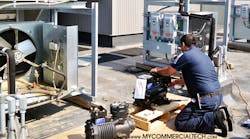The service salesperson has never had it easier. The technology we have today means we can cover more ground, be more accurate, and take more knowledge into a prospect’s office. Back in the day, things were VERY different.
As a rookie sales trainee, my first HVAC job was with a corporate giant and it required traveling to the home office for six weeks of training. Much of this training involved estimating. That’s when I bought my first sales tool: one of the first electronic, hand-held calculators on the market. The $129 was worth it for this four-function phenomenon. The other 32 guys and gals in my class were estimating with a boxful of pencils.
Today that four-function calculator has been replaced with software that cranks out estimates at the speed of light and, with little more than a key stroke, can change a preventive maintenance quote to full coverage. Annual escalations can be completed in seconds.
Another great tool for salespeople is the digital (tapeless) voice recorder. This device is small, easy to use, and makes it very easy to “take notes” while driving through my sales territory. I can dump the digital voice recordings onto my computer to refer back to as I do my research on potential clients. Very handy.
Once back at the office, the computer is the tool of choice. I type a potential client street address into the mapping software (Google Maps) and, zooming down from an aerial view, I can see the number of rooftop units and their size (I also note the number of condenser fans) on the building in question. I also check for low ambient units, which indicate the building has sophisticated information technology needs.
Next, I pan to the ground and make sure there aren’t more units, packaged chillers, or cooling towers. I also look for uninterruptable power sources (UPS). If there’s one present, coupled with some upper-end low ambient units, that usually means the computer room(s) are critical and the potential customer could be willing to spend more on maintenance.
While panning around the building, I note any adjoining parking lots. Here’s why: parking spaces are typically nine feet wide (other than handicap spots). By counting the number of parking stripes in the front and in a side lot, then multiplying by nine, I can approximate the building’s width and depth. This allows me to calculate square footage. For the building height, I just go to “street view” in Google Maps to see how many stories it is. This is obviously only an approximation but it’s all that‘s needed prior to the first sales call.
It is amazingly accurate. Once you have an idea of the square footage, you can divide 350 to 450 sq.ft./ton and get a good idea as to the total tonnage (based upon geographic location and design temperature).
Then, by multiplying the total estimated tonnage by another constant of $1,500 to $2,000 per ton (get this number from the building’s operations team), you can estimate the replacement cost of the HVAC systems. Imagine having all this info on your first sales call!
Back at the computer, as long as I’m still in the satellite aerial mode of Google Maps, I can scan the neighborhood to find other interesting buildings and perform the same research on those of interest.
Armed with this info, when I make the initial call and perform the visual survey from the roof or equipment room, I use my smart phone to take pictures of the nameplate on each unit (if you still have a dumb phone there are some great, cheap cameras that fit into your back pocket.)
When I get back to the office, I’ll print out the nameplate pictures for our service manager. This provides him with the condenser fan size, type of refrigerant used, the refrigerant charge number, along with the gas-fired information — great stuff to have on record.
Of course, I still take the pictures of dirty coils, broken belts, condensate leaks, refrigerant canisters strewn across the roof and all other indications of a less-than-adequate maintenance program.
Back inside the prospect’s building, I make sure to ride the elevator, because the elevator certificate usually provides a contact name. I also get a lot of info from the county tax assessor’s web site. This will show the ownership and every permit pulled for tenant improvements.
The technology available to salespeople today is really “da bomb!” Using it lets us work smarter and more importantly, quicker. Just think — someday we might be able to do everything from our cubicle.
Wait, that day is here.
Earl King is the founder of King Productions International, a commercial HVAC
contracting sales consulting firm based in Texas. He speaks to associations and HVAC trade groups, and consults with commercial contractors across the country, in addition to writing this column for Contracting Business.com. Email Earl with any questions or comments at: [email protected] or call him at 515/321-2426.






